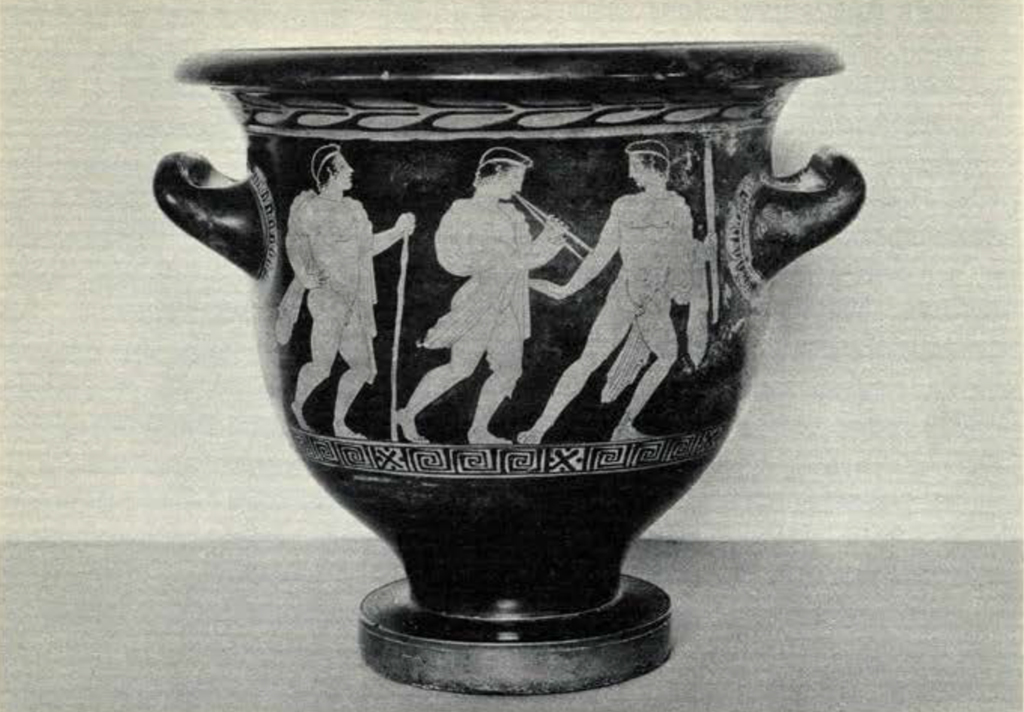SOME years ago Professor Alfred Mansfield Brooks of Swarthmore College had the good fortune to discover in the public market of Canterbury, England, the red-figured vase shown in Plate VII. He has very generously lent the vase to the Museum, where, since it was put on exhibition in the Sharpe Gallery, it has attracted the interest of art students and archaeologists, as well as of the casual visitor.
The vase is preserved intact, without a crack, but the black glaze which serves as ground for the design has suffered here and there some small damage.

Image Number: 2972
Kraters for mixing water and wine are known in every period of Greek vase-painting, but it is only just after the middle of the fifth century before Christ, in about 440, that this type of bell-krater with horizontal handles and simple foot was in vogue. This date is confirmed by both the subject and style of the pictures. On the obverse (above) are three revellers, not frenzied by wild orgies after the manner of maenads and satyrs, but discreetly keeping step to the tune played by the flutist in the center. The leader of the trio carries a torch to light the way. The man on the left carries a staff; his right hand is on his hip, his head slightly raised in the attitude in which singers are often depicted. All three boys wear fillets in honor of the celebration to which they are going or, more probably, from which they are returning. On the reverse (below) are three figures draped in himatia with their right shoulders bare. On the field is painted a pair of jumping-weights to show that the conversation takes place in the palaistra. The style of both pictures is competent and pleasant, but not in the grand manner of earlier days. The vase is roughly contemporary with the Parthenon sculptures, but vase-painting had run its course somewhat earlier than sculpture and in the tranquil days which preceded the Peloponnesian war vase-painters were walking the ways of pleasantness.
If now we try to ascertain the painter of this vase, we find in Till-yard’s catalogue of the Hope Vases another bell-krater (no. 138) which closely resembles ours. In its obverse picture are again depicted three revellers, the central one a flutist, the leader looking back with his right hand extended, exactly as on our vase, the last of the trio a singer. The manner in which the himatia are worn loosely about the shoulders is quite the same. On the reverse are repeated the three draped figures with their right shoulders bare. Exactly similar, also, to the patterns on our vase are the laurel wreath below the rim, the pattern of three maeanders broken by saltire squares below the pictures, the egg-pattern below the bases of the handles. There can be no doubt that the two vases are painted by the same hand. Professor Beazley of Oxford has named the artist who pointed this companion piece to our vase the Christie Pointer after its present owner, and to the same hand has ascribed twenty vases. Professor Brooks’ vase makes the twenty-first to be identified as the work of the Christie Painter. Professor Beazley has kindly confirmed this attribution.

Image Number: 2973
The suspicion arises that the Brooks vase may also have belonged at one time to the Hope collection at the Deepdene and somehow strayed thence to the small shop where it was purchased. If so, it is interesting to recall that the Hope vases catalogued by Tillyard represent the second collection of Greek vases assembled by Sir William Hamilton, British Envoy and Plenipotentiary at the court of Naples. Many vases in this collection were drawn at Naples by Tischbein, but not all. After the rise of Napoleon, Hamilton decided that his vases would be safer in England and had them packed in twenty-four cases and shipped on the Colossus, which, however, was shipwrecked off the Scilly Isles with the loss of a third of the vases. The remaining two-thirds were later bought by Thomas Hope in 1801, who subsequently sold some of the vases in his collection and added others. It is thus impossible now to trace our vase to the Hope collection and still more so to the collection of Sir William Hamilton, especially as it does riot appear among Tischbein’s drawings, whereas its companion piece in the Christie collection was drawn by Tischbein. But the close correspondence between the two vases and the fact that the Brooks vase was offered for sale in a town so near to the Deepdene, the country seat in Surrey of the Hope family, lends considerable probability to the supposition that Professor Brooks’ vase also belonged once to the famous Hamilton collection in Naples.
E. H. D.

